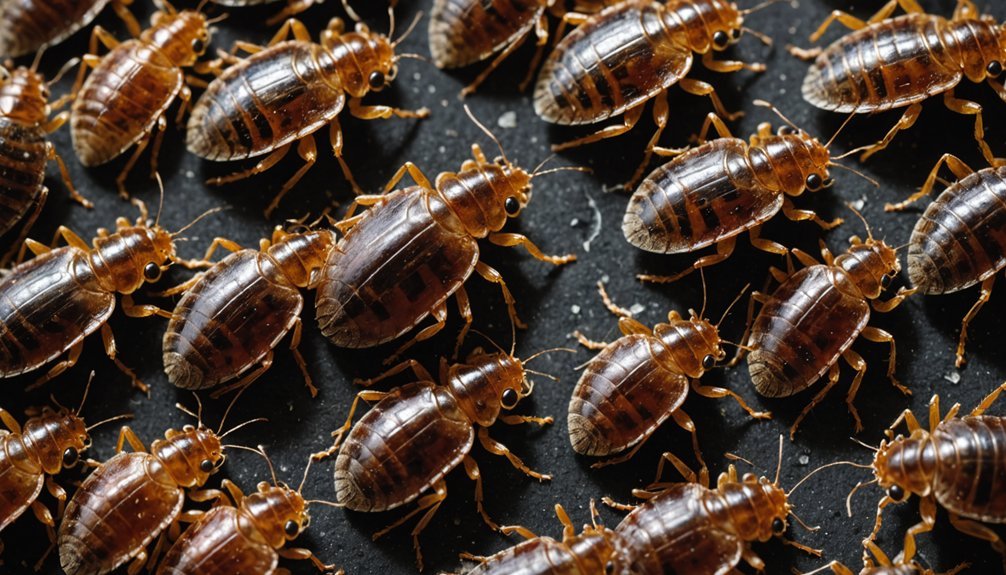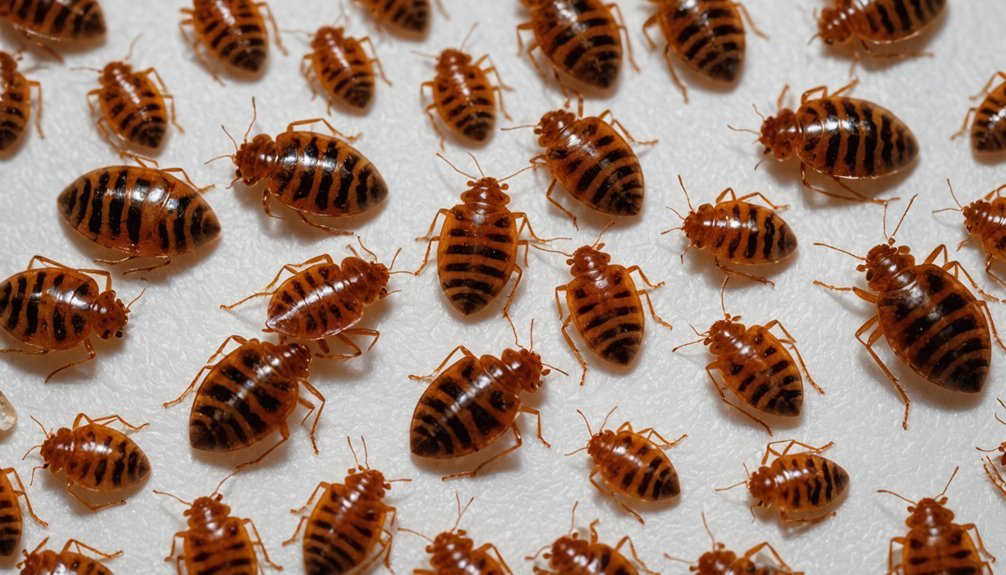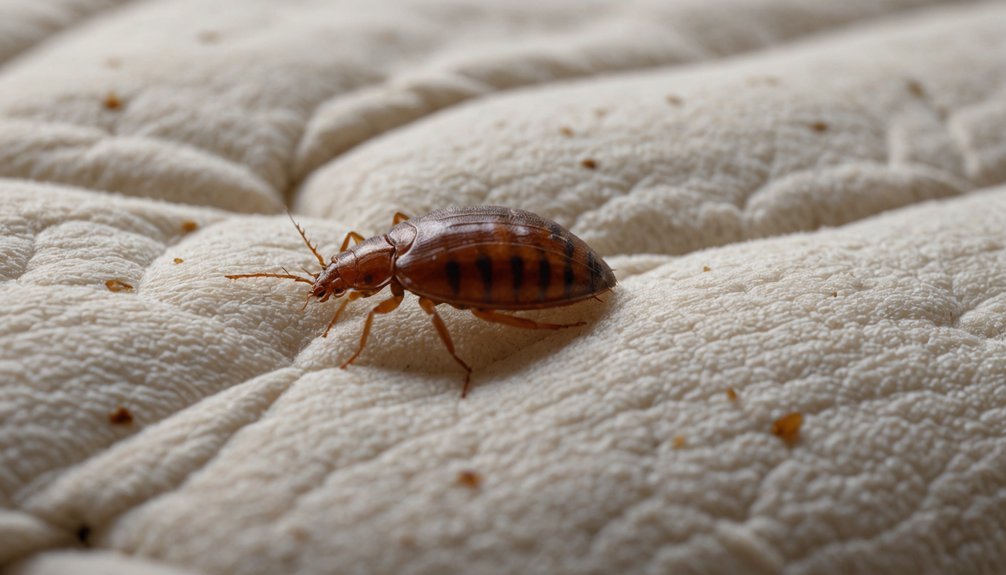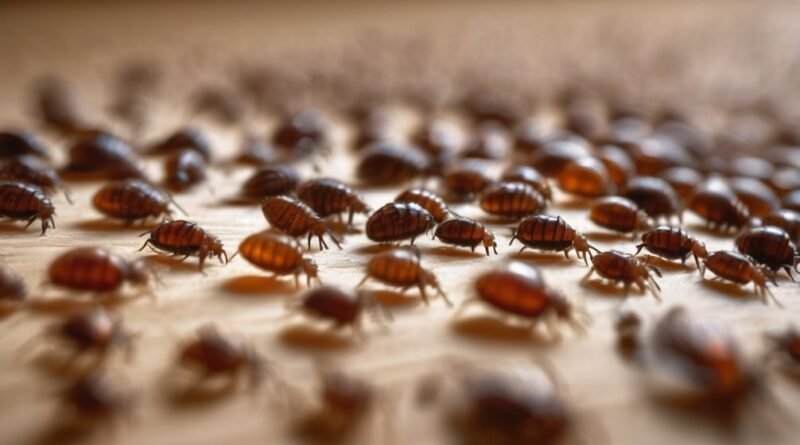Bed Bug Shells, Casings & Droppings: How to Spot Them
If you’ve spotted mysterious oval shells or dark stains on your mattress, you’re likely dealing with bed bugs. These resilient pests leave behind distinct evidence of their presence, from translucent casings to ink-like droppings that can tell you exactly how severe your problem is. Learning to identify these telltale signs won’t just confirm your suspicions – it’ll help you take control of the situation before these unwanted visitors make themselves too comfortable.
Key Takeaways
- Look for hollow, oval-shaped exoskeletons measuring 1/16 to 3/8 inch with reddish-brown coloring along mattress seams and furniture cracks.
- Dark, rusty stains that smear when wiped and smell like musty coriander indicate bed bug activity, especially near headboards.
- Black droppings appear as tiny ink-like dots or smears, typically 1-2mm wide and clustered in areas of infestation.
- Translucent shed skins from molting appear in various sizes, indicating active infestations when multiple casings are present.
- Check for tiny pale yellow eggs and rusty blood stains using a flashlight, focusing on mattress seams and furniture joints.
What Bed Bug Shells and Casings Look Like

Bed bug shells and casings are distinctive signs of an infestation that you’ll find scattered near their hiding spots. These hollow, oval-shaped exoskeletons range from 1/16 to 3/8 inch in length, appearing in various sizes as nymphs progress through five growth stages.
You’ll notice these casings have a papery, fragile texture and typically display reddish-brown or dark rusty coloring, though they can also appear translucent or whitish, especially as they age. Their thin, crinkly nature makes them different from harder insect shells you might encounter. These casings help bed bugs rid parasites from their bodies during molting.
If you spot multiple sizes of casings in one area, it’s a clear indicator that bed bugs are actively growing and molting. Look for them in mattress seams, bed frames, and furniture cracks where bed bugs commonly hide.
Signs of Bed Bug Droppings and Stains

You’ll spot bed bug droppings as dark, rusty stains that resemble ink marks, often clustered in hidden areas near their harborage points.
These telltale black spots typically appear along mattress seams, behind headboards, and inside box spring creases where the bugs congregate.
The fecal matter leaves distinctive stains that smear when wiped and can help you track the bugs’ movement patterns through your home. When investigating possible infestations, these droppings often emit a musty coriander scent.
Black Spotting Patterns
When inspecting for bed bug activity, you’ll need to watch for their telltale black droppings, which appear as tiny ink-like dots or smears roughly 1-2 millimeters wide.
These dark brown to black stains result from digested blood and typically cluster in groups rather than appearing as isolated spots.
You’ll find these spotting patterns most commonly in mattress seams, tufts, and labels, as well as bed frame joints where bugs tend to aggregate. During severe infestations, you may notice these stains appearing as smudges on walls, especially near baseboards and cracks.
The spots often soak into fabric, creating blurred edges that resemble marker stains.
Unlike rust-colored stains from crushed bugs, these droppings are pure black or dark brown.
While checking light-colored fabrics makes spots easier to identify, don’t forget to examine darker materials for subtle smudging.
Use a flashlight and magnifying glass to inspect seams, folds, and furniture joints thoroughly.
Rusty Stain Identification
To accurately identify bed bug infestations, look for distinctive rusty-brown stains that range from 1mm dots to larger smears on mattresses, headboards, and nearby walls.
You’ll find these stains clustered near bed bug hiding spots, especially in mattress seams and wooden bed frames.
Test suspicious spots by wiping them with a damp tissue – bed bug droppings will create rusty-colored smudges.
Unlike cockroach droppings, which appear as rectangular pellets, bed bug stains look more like ink blots.
They’ll often be accompanied by shed skins and a musty odor.
These stains are particularly persistent on porous surfaces like fabric and wood, where they absorb deeply into the material.
While the stains don’t transmit disease, they indicate active feeding and require immediate attention to prevent the infestation from spreading. Professional canine detection can reliably confirm bed bugs in areas where stains are found.
Hidden Fecal Matter Locations
Numerous bed bug droppings can be found in hidden locations throughout your home, particularly near sleeping areas and resting spots. You’ll notice small black or brown ink-like spots that smear when wiped with a damp cloth, leaving brownish stains. These droppings often bleed red when moistened, helping distinguish them from other pest feces. A strong locker room smell often accompanies areas with heavy fecal matter accumulation.
| Location | What to Look For | Key Indicators |
|---|---|---|
| Mattress Areas | Dark spots on seams, piping, tags | Sticky residue, clustered spots |
| Furniture | Speckling in joints, creases | Stains on wood, near staples |
| Walls & Baseboards | Streaks behind wallpaper, paint | Trailing marks from hiding spots |
| Personal Items | Spots on books, frames, curtains | Feces with shed skins nearby |
Check these areas thoroughly, as large concentrations of droppings indicate active infestations requiring immediate treatment.
Key Locations to Check for Evidence

Five key areas require thorough inspection when checking for bed bug evidence. Start with mattresses and box springs, examining seams, tufts, tags, and edges for shells and droppings.
Next, check bed frames and furniture, focusing on screw holes, joints, and upholstered seams where casings often accumulate.
Don’t forget wall gaps and baseboards, where you’ll find fecal stains and shed skins behind loose wallpaper, electrical outlets, and inside heater units.
Inspect personal items near sleeping areas, including books, curtains, and electronics for signs of activity.
Finally, expand your search to an eight-foot radius around sleeping spots, paying special attention to carpet edges, couch cushions, and cluttered areas where bed bugs frequently leave evidence of their presence.
Understanding the Molting Process
While bed bugs appear simple from the outside, their growth process involves a complex series of molts that require blood meals to succeed. Each bed bug goes through five nymphal stages before reaching adulthood, molting their exoskeleton every 5-8 days after feeding.
Despite their basic appearance, bed bugs undergo an intricate growth cycle of five molts, each requiring fresh blood to advance.
You’ll notice these molted casings, called exuviae, as translucent shells that look like empty versions of the bugs. They’re often found in bed bug hiding spots, like mattress seams and crevices.
When you find multiple casings of different sizes, it’s a clear sign of an active infestation where bugs are feeding and growing.
Without blood meals, nymphs can’t molt and will die. This process continues until they reach adulthood, which takes about 37 days under ideal conditions.
Distinguishing Between Live Bugs and Empty Shells
Now that you understand the molting process, being able to tell live bed bugs from their empty shells is a key identification skill.
Live bugs appear reddish-brown with solid, opaque bodies and move quickly when disturbed. Their shells, on the other hand, are translucent, lighter in color, and remain stationary.
You’ll find both in similar hiding spots like mattress seams and headboards, but shells often cluster where bugs molt.
While handling shells, they’ll feel brittle and may crumble, unlike live bugs which are soft and flexible.
Look for split marks along the back of shells where bugs emerged. If you spot shells alongside eggs, fecal spots, and blood stains, you’re likely dealing with an active infestation.
When in doubt, it’s best to consult a pest control professional for accurate identification.
Early Warning Signs and Detection Methods
Early detection of bed bug infestations requires vigilance and knowledge of key warning signs.
Spotting bed bug problems early demands careful attention and understanding of telltale indicators that signal their presence.
You’ll want to look for tiny pale yellow eggs near mattress seams, black excrement dots on sheets, and rusty blood stains on furniture surfaces. Use a flashlight and magnifying glass during your inspections to spot translucent shed skins.
Place pitfall traps under furniture legs and remove any bridges between the floor and furniture to maximize trap effectiveness.
Watch for clusters of small, itchy bites on exposed skin areas, though some people won’t show bite reactions. You might notice newly hatched nymphs, which are pinhead-sized and whitish before feeding, turning bright red afterward. A sweet, musty odor can indicate heavy infestations.
Regular monitoring with both visual inspections and traps provides the most reliable detection method.
Conclusion
You’ll need to act quickly when you spot bed bug evidence like shells, casings, or droppings. Don’t ignore these warning signs – they’re clear indicators of an active infestation. Check your mattress seams and furniture regularly, and if you find any suspicious marks or molted shells, contact a pest professional immediately. Early detection‘s your best defense against these persistent pests.

